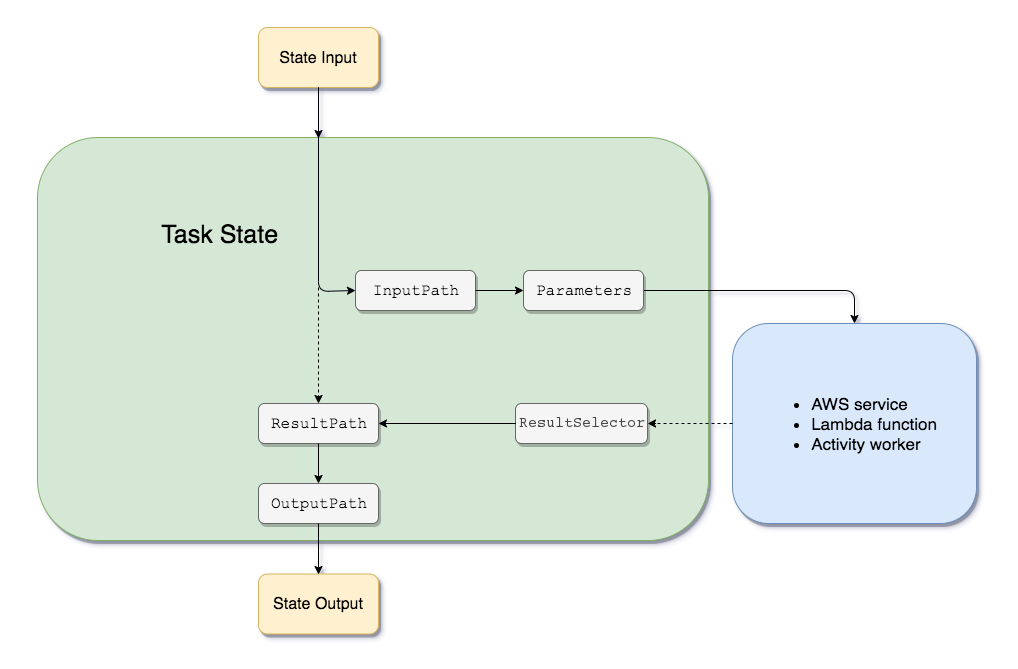How to work with AWS Step Functions
In this blog post, I will discuss how to get start with AWS Step Functions. Why use it and how to use it.
AWS Step Functions is a low-code, visual workflow service that developers use to build distributed applications, automate IT and business processes, and build data and machine learning pipelines using AWS services.
Step Functions are actually an extension of the Lambda function, allowing you to combine several Lambda functions to call each other.
Getting started
To effectively design and implement workflows in AWS Step Functions first let us practice, let us login to our AWS web console
https://aws.amazon.com/console/
and let us create a step function.

Then we create a state machine

We select write workflow code

and let us just continue with the Hello World example

we choose create with the default settings and create.
We select our State machine and press Start Execution

We keep the default JSON input and click Start Execution

A Step Functions execution receives a JSON text as input and passes that input to the first state in the workflow. Individual states receive JSON as input and usually pass JSON as output to the next state.

After the execution you can see that was Succeeded and the deployed picture as below

Good! Now we have created and executed our Hello World Step function. Let us now analyze in detail how this information flows from state to state, and learning how to filter and manipulate this data.
States
A state can be any string but must be unique within the scope of the entire state machine. It does the following functions:
- Performs some work in the state machine (a Task state).
- Makes a choice between branches of execution (a Choice state).
- Stops execution with failure or success (a Fail or Succeed state).
- Simply passes its input to its output or injects some fixed data (a Pass state).
- Provides a delay for a certain amount of time or until a specified time/date (a Wait state).
- Begins parallel branches of execution (a Parallel state).
From our Hello World JSON example for our step function definition ,
we have a Comment of the step fuction, StartAt, we select where starts
and settings of the states in States, the result in Result and the second state
with Next following with the word World. This name should be used as the name of the next state otherwise is wrong the definition, an finally finish with End
{
"Comment": "A Hello World example of the Amazon States Language using Pass states",
"StartAt": "Hello",
"States": {
"Hello": {
"Type": "Pass",
"Result": "Hello",
"Next": "World"
},
"World": {
"Type": "Pass",
"Result": "World",
"End": true
}
}
}
and our execution input is our State-input
{
"Comment": "Insert your JSON here"
}
Task type
An example of a state definition for Task type:
"States": {
"FirstState": {
"Type": "Task",
"Resource": "arn:aws:lambda:ap-southeast-2:710187714096:function:DivideNumbers",
"Next": "ChoiceState"
}
A Task is the basic unit of work in Step Functions. It represents a single unit of work performed by a state machine
You can define a Task by setting a state to “Type”: “Task” and providing the Amazon Resource Name (ARN) of the activity or Lambda function the Task should invoke.
How to pass data to AWS Step Functions
There are two ways to pass arguments through state machine. Via InputPath and Parameters. For differences please look here.
If you do not have any static values that you want to pass to lambda, I would do the following. Passed all parameters to step function in JSON format. For example an Input JSON for state machine
{
"foo": 123,
"bar": ["a", "b", "c"],
"car": {
"cdr": true
}
"TableName": "table_example"
}
A path is a string beginning with $ within the Amazon States Language, and you can use it to identify components found inside the JSON text.
With reference paths will return:
$.foo => 123
$.bar =>["a","b","c"]
$.car.cdr= true
In step function you are passing entire JSON explicitly to lambda using "InputPath": "$", except for a first step where it is passed implicitly.
You can specify a path that will allow you access to subsets of the input when you’re determining the values for InputPath, ResultPath, and the OutputPath.
For more about $ path syntax please look here. You also need to take care of task result, with one of multiple approaches using ResultPath.
For most of cases the safest solution is to keep task result in special variable "ResultPath": "$.taskresult"
{
"Comment": "A Hello World example of the Amazon States Language using an AWS Lambda function",
"StartAt": "HelloWorld",
"States": {
"HelloWorld": {
"Type": "Task",
"Resource": "arn:aws:lambda:ap-southeast-2:XXXXXXX:function:fields_sync",
"Next": "HelloWorld2"
},
"HelloWorld2": {
"Type": "Task",
"InputPath": "$",
"ResultPath": "$.taskresult"
"Resource": "arn:aws:lambda:ap-southeast-2:XXXXXXX:function:fields_sync_2",
"End": true
}
}
}
Which in lambda became event variable and can be access as python dictionary
def lambda_handler(event, context):
table_example = event["TableName"]
a = event["bar"][0]
cdr_value = event["car"]["cdr"]
# taskresult will not exist as event key
# only on lambda triggered by first state
# in the rest of subsequent states
# it will hold a task result of last executed state
taskresult = event["taskresult"]
With this approach you can use multiple step functions and different lambdas and still keep both of them clean and small by moving all the logic in lambdas. Also it is easier to debug because all events variables will be the same in all lambdas, so via simple print(event) you can see all parameters needed for entire state machine and what possibly went wrong.
Input and Output
In the Amazon States Language, these fields filter and control the flow of JSON from state to state:
- InputPath selects which parts of the JSON input to pass to the task of the
Taskstate . - OutputPath can filter the JSON output to further limit the information that’s passed to the output.
- ResultPath then selects what combination of the state input and the task result to pass to the output.
- InputPath, Parameters, ResultSelector, ResultPath, and OutputPath each manipulate JSON as it moves through each state in your workflow.
The following diagram shows how JSON information moves through a task state.

InputPath
It would be best if you used InputPath so you could select a segment of the state input
Let us take an example,where we assign a Lambda execution, within Input like below.
{
"comment": "exam results.",
"result": {
"math": 80,
"eng": 93
},
"extra": "foo",
"lambda": {
"who": "AWS Step Functions"
}
}
That input is bound to the symbol $ and passed on as the input to the first state in the state machine. By default, the output of each state would be bound to $ and becomes the input of the next state. The state machine definition is as below:
{
"Comment": "A Hello World example of the Amazon States Language using an AWS Lambda function",
"StartAt": "ExamResults",
"States": {
"ExamResults": {
"Type": "Task",
"Resource": "arn:aws:lambda:us-east-1: 3123456789012:function:HelloFunction",
"InputPath": "$.lambda",
"ResultPath": "$.result.total",
"OutputPath": "$.result",
"End": true
}
}
}
In Each state, we have InputPath, ResultPath and OutputPath attributes which filters the input and provide the final output. In the above scenario, “ExamResults” state is filtering “lambda” node, appending the result of a state execution to “results” node and final output is just “result” node rather than the whole JSON object.
In other words, given $ as an input to the state machine
{
"comment": "Exam Results.",
"result": {
"math": 0,
"eng": 93
},
"extra": "foo",
"Lambda": {
"who": "AWS Step Functions"
}
}
by using $.lambda in "InputPath" : "$.lambda" will filter the Input JSON of state machine and pass only lambda node to the "ExamResults" state as an input
{
"who": "AWS Step Functions"
}
by using $.result.total in "ResultPath" : "$.result.total" takes whole $ output
json, and adds the output of state task execution with “total” attribute inside “result” node.
{
"comment": "exam results.",
"result": {
"math": 80,
"eng": 93,
"total": 173
},
"extra": "foo",
"lambda": {
"who": "AWS Step Functions"
}
}
Hence, the final output with $.result the "OutputPath" : "$.result" filters the $ output json and pass only "result" as a final output of the state
{
"math": 80,
"eng": 93,
"total": 173
}
Parameters
Using the Parameters field will help you create a collection of key-value pairs that are all passed as input. These values can be selected from an input or context object with a path, or they can be static values that you’ve included within your state machine definition. The key name must end in *.$* for key-value pairs whose value was selected using a path.
Take a look at the following input example:
{
"coment": "Example for Parameters.",
"product": {
"details": {
"color": "blue",
"size": "small",
"material": "cotton"
},
"availability": "in stock",
"sku": "2317",
"cost": "$23"
}
}
Specifying these parameters within your state machine definition will enable you to select some of the information.
"Parameters": {
"comment": "Selecting what I care about.",
"MyDetails": {
"size.$": "$.product.details.size",
"exists.$": "$.product.availability",
"StaticValue": "foo"
}
},
Considering the previous input along with the Parameters field, this is the JSON that’ll pass:
{
"comment: "Selecting what I care about.",
"MyDetails": {
"size": "small",
"exists": "in stock",
"StaticValue": "foo"
}
},
In addition to the provided input, you’ll easily access a special JSON object that’s known as “context object.” This object includes all information regarding your state machine execution.
Congratulations! We have reviewed some points of the Step Functions.

Leave a comment